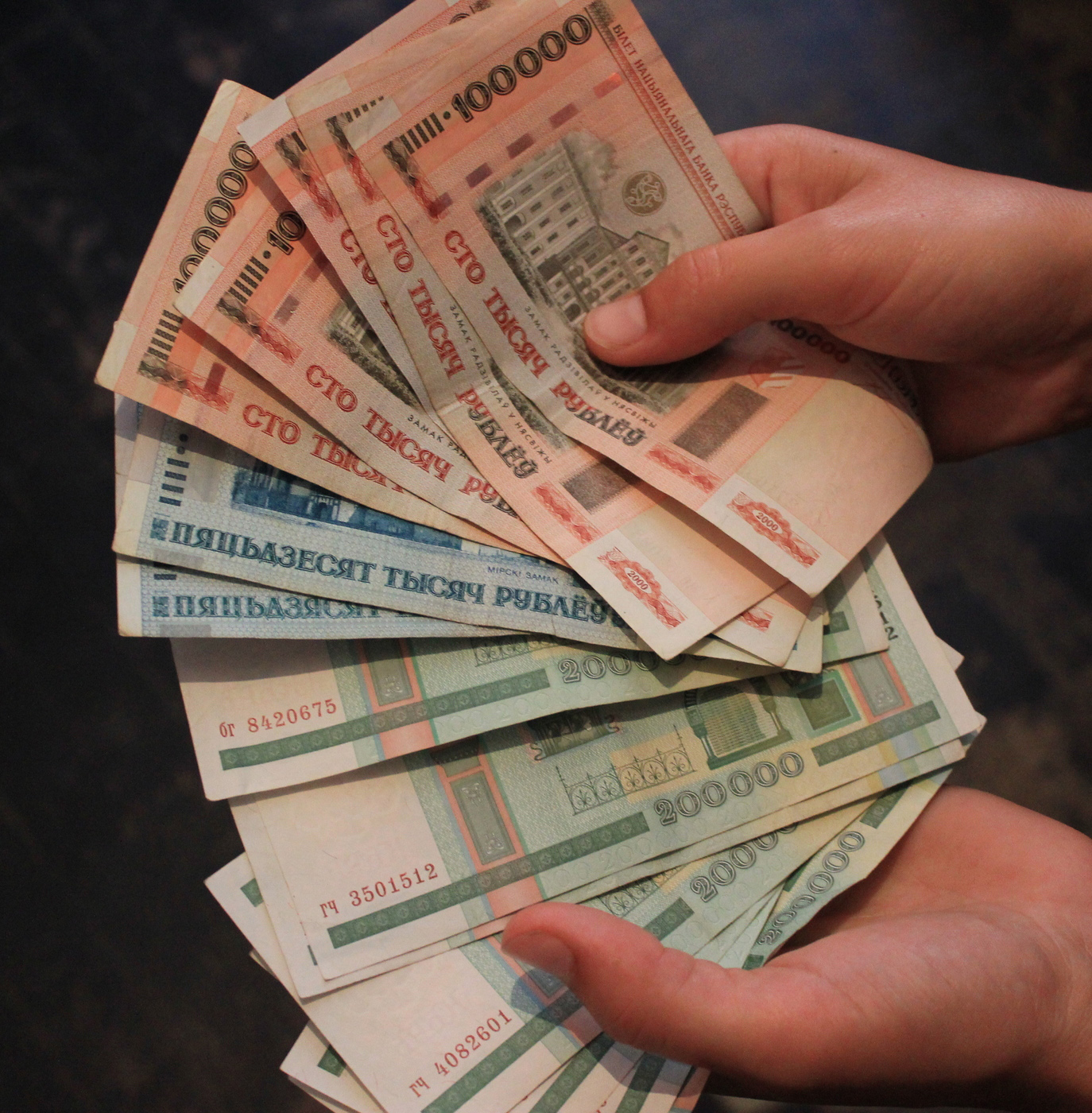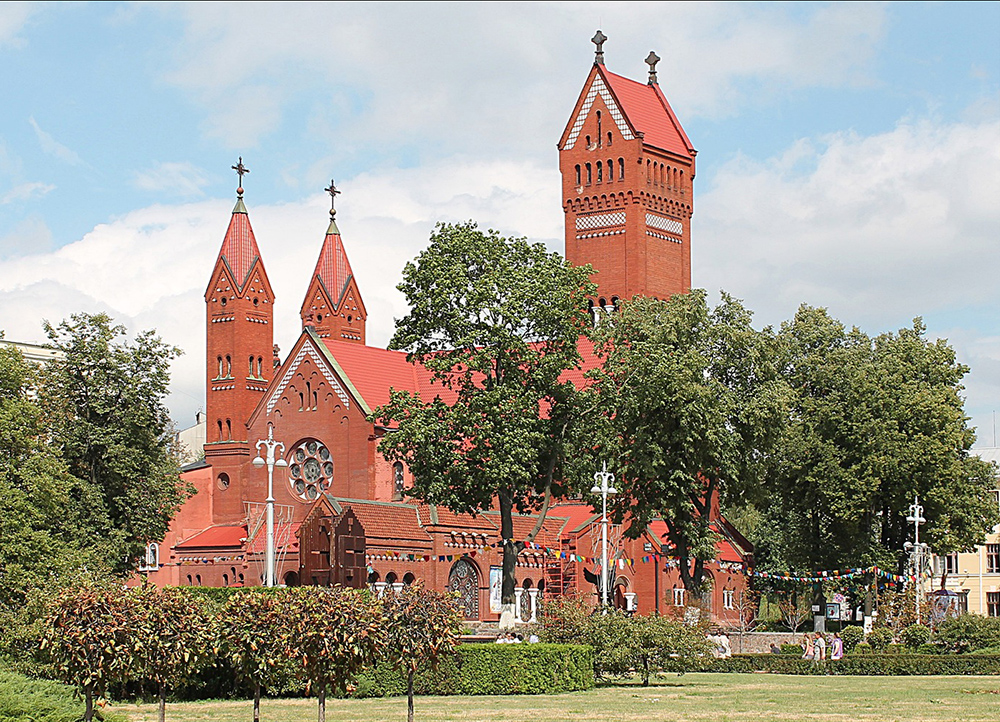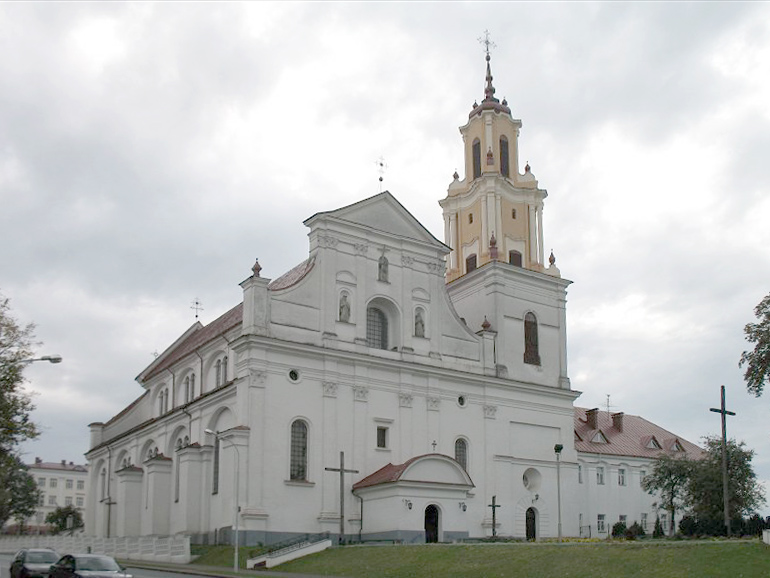Languages: Belarusian (official) 23.4%, Russian (official) 70.2%, other 3.1% (includes small Polish- and Ukrainian-speaking minorities), unspecified 3.3% (2009 est.)
Ethnicity/race: Belarusian 83.7%, Russian 8.3%, Polish 3.1%, Ukrainian 1.7%, other 2.4%, unspecified 0.9% (2009 est.)
Religion: Eastern Orthodox 80%, other (including Roman Catholic, Protestant, Jewish, and Muslim) 20% (1997 est.)

National Holiday: Independence Day, July 3
Literacy rate: 99.6% (2009 est.)
Economic summary
 GDP/PPP (2013 est.): $69.24 billion; per capita $16,100. Real growth rate: 2.1%. Inflation: 19%. Unemployment: 1% (2009 est.) officially registered unemployed; large number of underemployed workers. Arable land: 26.63%. Agriculture: grain, potatoes, vegetables, sugar beets, flax; beef, milk. Labor force: 5 million (2009); agriculture 9.4%, industry 45.9%, services 44.7% (2003 est.). Industries: metal-cutting machine tools, tractors, trucks, earthmovers, motorcycles, televisions, chemical fibers, fertilizer, textiles, radios, refrigerators. Natural resources: forests, peat deposits, small quantities of oil and natural gas, granite, dolomitic limestone, marl, chalk, sand, gravel, clay. Exports: $45.17 billion (2013 est.): machinery and equipment, mineral products, chemicals, metals, textiles, foodstuffs. Imports: $45.17 billion (2012 est.): mineral products, machinery and equipment, chemicals, foodstuffs, metals. Major trading partners: Russia, Netherlands, Germany, Ukraine, China, Latvia (2012).
GDP/PPP (2013 est.): $69.24 billion; per capita $16,100. Real growth rate: 2.1%. Inflation: 19%. Unemployment: 1% (2009 est.) officially registered unemployed; large number of underemployed workers. Arable land: 26.63%. Agriculture: grain, potatoes, vegetables, sugar beets, flax; beef, milk. Labor force: 5 million (2009); agriculture 9.4%, industry 45.9%, services 44.7% (2003 est.). Industries: metal-cutting machine tools, tractors, trucks, earthmovers, motorcycles, televisions, chemical fibers, fertilizer, textiles, radios, refrigerators. Natural resources: forests, peat deposits, small quantities of oil and natural gas, granite, dolomitic limestone, marl, chalk, sand, gravel, clay. Exports: $45.17 billion (2013 est.): machinery and equipment, mineral products, chemicals, metals, textiles, foodstuffs. Imports: $45.17 billion (2012 est.): mineral products, machinery and equipment, chemicals, foodstuffs, metals. Major trading partners: Russia, Netherlands, Germany, Ukraine, China, Latvia (2012).
Communications
Telephones: main lines in use: 4.407 million (2012); mobile cellular: 10.675 (2012). Broadcast media: 4 state-controlled national TV channels; Polish and Russian TV broadcasts are available in some areas; state-run Belarusian Radio operates 3 national networks and an external service; Russian and Polish radio broadcasts are available (2007). Internet hosts: 295,217 (2012). Internet users: 2.643 million (2009).
Transportation
Railways: total: 5,512 km (2004). Highways: total: 79,990 km; paved: 69,351 km; unpaved: 10,639 km (2004). Waterways: 2,500 km (use limited by location on perimeter of country and by shallowness) (2003). Ports and harbors: Mazyr. Airports: 101 (2005).
International disputes
Boundary demarcated with Latvia and Lithuania; as a member state that forms part of the EU's external border, Poland has implemented strict Schengen border rules to restrict illegal immigration and trade along its border with Belarus.
Cities and Towns in the Tours
Minsk
 Minsk (Belarusian: Мінск, pronounced [mʲinsk]; Russian:Минск, [mʲinsk]) is the capital and largest city of Belarus, situated on the Svislach and the Nyamiha Rivers. As the national capital, Minsk has a special administrative status in Belarus and is the administrative centre of Minsk Region (voblast) and Minsk raion (district). In 2013, it had a population of 2,002,600. Minsk is the administrative capital of the Commonwealth of Independent States (CIS) and seat of the Executive Secretary.
Minsk (Belarusian: Мінск, pronounced [mʲinsk]; Russian:Минск, [mʲinsk]) is the capital and largest city of Belarus, situated on the Svislach and the Nyamiha Rivers. As the national capital, Minsk has a special administrative status in Belarus and is the administrative centre of Minsk Region (voblast) and Minsk raion (district). In 2013, it had a population of 2,002,600. Minsk is the administrative capital of the Commonwealth of Independent States (CIS) and seat of the Executive Secretary.
Brest
Brest (Belarusian: Брэст, Polish: Brześć, Russian: Брест Brest, Ukrainian: Берестя Berestia, Yiddish: בריסק Brisk), formerly Brest-Litowsk (Belarusian: Брэст-Лiтоўск; Polish: Brześć Litewski) (Brest-on-the-Bug, Polish: Brześć nad Bugiem), is a city (population 347,576 in 2018) in Belarus at the border with Poland opposite the Polish city of Terespol, where the Bug and Mukhavets rivers meet. It is the capital city of the Brest Region.
Gomel
Gomel (Homieĺ, also Homiel, Homel or Homyel’; Belarusian: Го́мель,Łacinka: Homiel, pronounced [ˈɣomʲelʲ], Russian: Го́мель, pronounced [ˈɡomʲɪlʲ]) is the administrative centre of Gomel Region and with 526,872 inhabitants (2015 census) the second-most populous city of Belarus.
Grodno
 Grodno or Hrodna (Belarusian: Гродна, Hrodna [ˈɣdna]; Russian: Гродно, tr. Grodno, IPA: [ˈɡrodnə]) is a city in western Belarus. It is located on the Neman close to the borders of Poland and Lithuania (about 20 km (12 mi) and 30 km (19 mi) away respectively). It has 365,610 inhabitants (2016 census).
Grodno or Hrodna (Belarusian: Гродна, Hrodna [ˈɣdna]; Russian: Гродно, tr. Grodno, IPA: [ˈɡrodnə]) is a city in western Belarus. It is located on the Neman close to the borders of Poland and Lithuania (about 20 km (12 mi) and 30 km (19 mi) away respectively). It has 365,610 inhabitants (2016 census).
Mogilev
Mogilev (official transliteration: Mahilioŭ; also Mahilyow; Belarusian: Магілёў, pronounced [maɣʲiˈlʲou̯]; Łacinka: Mahiloŭ; Russian: Могилёв, pronounced [məɡʲɪˈlʲof]; Yiddish:מאָליעוו, Molyev) is a city in eastern Belarus, about 76 kilometres (47 miles) from the border with Russia's Smolensk Oblast and 105 km (65 miles) from the borderwith Russia's Bryansk Oblast. As of 2011, its population was 360,918, up from an estimated 106,000 in 1956.
Mir
Mir (Belarusian: Мір; Russian: Мир; both meaning "world" and "peace"; but the name most likely originates from the name of the river the settlement is situated on) is a town in Kareličy (Карэлічы) raion, Hrodna Voblast, Belarus on the banks of Miranka River, about 85 kilometers southwest of the national capital, Minsk.
Vitebsk
Vitebsk, Viciebsk (Belarusian: Ві́цебск, Łacinka: Viciebsk, pronounced [ˈvʲitsʲepsk]; Russian: Витебск, pronounced [ˈvʲitʲɪpsk]), is a city in Belarus. The capital of the Vitebsk Region, it had 342,381 inhabitants in 2004, making it the country's fourth-largest city.
